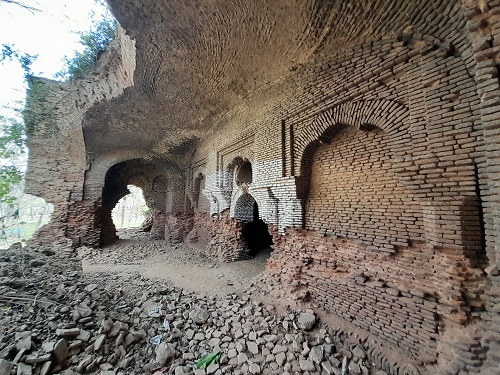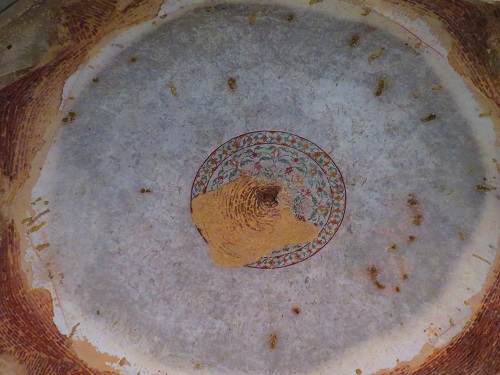Opening Note: This is the first of a multiple-part story. It is about a family of nobles that seems to turn up repeatedly while studying Mughal history, making themselves almost indispensable across several generations of rulers, beginning with Akbar and going on till Aurangzeb’s successors, encompassing a period of over 130 years.
While the stories of some of these individuals have been told – indeed some have become the subject of books – a single narrative capturing the entire family has yet to be seen. The idea of putting it together came while walking through a tumble-down tomb near the banks of a river. A river in a village called Sheikhupur. A village that lies 5 kms outside the small town of Badaun. A small town, 51 kms from Bareilly, that lives up to the phrase of ‘one-horse’. Bareilly, 250 kms from the capital of Uttar Pradesh and nearly 300 kms from the national capital, is itself is nothing to write home about as towns go. But to those living in Badaun, it symbolizes a big city.

A tiny railway station that indicates how small Sheikhupur is
The tomb of Parwar Khanum
Now that we’ve established that the tomb is in an obscure place, let’s turn our attention to the mausoleum itself. The structure lies amidst thick trees, with the river walking distance away.

The graveyard hidden behind a screen of trees

Spotted – last resting place of Parwar Khanum

The tomb of Parwar Khanum, fast disintegrating
All around are graves, with some looking recent. Obviously, while this is an old necropolis, it remains in use. The tomb itself stands on a high platform, with all sides having arched entrances topped by a dome. A visitor passes through the arches to walk into a corridor which runs all around a central tomb chamber.

Inside the tomb of Parwar Khanum – a ruined and crumbling outer corridor
Inside are several graves built on and around a central platform. One of these graves, probably the one in the middle, is of prime interest. Buried within is a lady called Parwar Khanum.

Grave of Parwar Khanum

Fading ceiling patterns inside the tomb
She was the wife of Sheikh Ibrahim (also called Mohtashim Khan, sometimes referred to as Farid Sheikh too), the son of Qutubuddin Koka, who was the governor of Badaun.
Koka’s imperial connection
According to historians, Qutubuddin Koka was the foster brother of the Mughal Emperor Jahangir – which would have given him considerable clout around court – and is said to also have been the emperor’s secretary and later governor of the rich province of Bengal as well.
Beyond his own status, Koka also came from an illustrious family. He was the grandson of Sheikh Salim Chisti, the Sufi held in great regard by Akbar and whose tomb was built inside that emperor’s fort complex at Fatehpur Sikri. It was a daughter of Salim Chisti who was foster mother to Jahangir and as a result, the two boys may have been close. It is sometimes said that the place called Sheikhupur was so named in remembrance of the boyhood name of Jahangir, ‘Sheikhu’.
Parwar Khanum’s parental family
But the family of nobles mentioned at the start of this story is not that of Qutabuddin Koka, but that of his daughter-in-law, Parwar Khanum. Parwar was the daughter of Abul Hasan (also known as Asaf Khan), a powerful Mughal nobleman.

Asaf Khan (Abul Hasan); Pic source: Wikipedia
A daughter of Hasan marrying a son of Qutubuddin Koka was thus a match between two influential families of Mughal nobility.
There was an even more illustrious match too, among Parwar’s siblings. Her sister, Arjumand Bano Begum, married Jahangir’s son Prince Khurram. Khurram’s ascending the throne as Shah Jahan would have been Abul Hasan’s moment of glory. Among the children born of this alliance was the future emperor Aurangzeb, which essentially meant that all emperors beyond this were also descendants of Asaf Khan too. And by extension, Aurangzeb was the nephew of Parwar Khanum.
Compare the sisters…and their resting places
The way things panned out, Parwar Khanum married into a powerful noble family, almost equal in status to the one she was born into. Her sister, however, went one better – marrying a future emperor was definitely better than a nobleman. While a noble family may fall on evil days if they were to lose the ruler’s favour, it was less probable that the emperor would lose his throne.
Hence while Parwar Khanum was eventually confined to a tomb in tiny Sheikhupur, Badaun, her sister Arjumand Bani Begum was titled ‘Mumtaz Mahal’ and when she eventually died, a Taj Mahal came up as her last resting place. While the Taj is still India’s most visited monument, and is a UNESCO World Heritage site, Parwar Khanum’s tomb is nearing collapse and to visit it, one has to walk through a rubbish dump. While one sister’s descendants were Mughal emperors, those of the other gradually sank into a quiet life at Sheikhupur.

While one sister rests inside India’s most visited monument, the tomb of the other…

The path to the other sister’s tomb is accessed via this rubbish dump
Of course, the hand of time is fairly democratic. Eventually, the emperors too have vanished and Mumtaz Mahal’s descendants are probably in no better state today than those of her sister. Though looking at an old haveli in Sheikhupur, one gets the sense that when the storm comes, it is easier for a poor, obscure Nawab to ride it out than for an Emperor.
In the next part of the story about the first family of Mughal nobility, we will go back to its founder in India, Mirza Ghiyas Beg. Read the next part here: https://hiddenheritage.in/2023/06/25/first-family-of-mughal-nobility-ii-the-life-of-mirza-ghiyas-beg/





